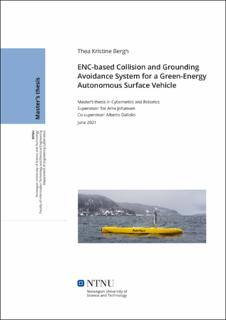| dc.contributor.advisor | Johansen, Tor Arne | |
| dc.contributor.advisor | Dallolio, Alberto | |
| dc.contributor.author | Bergh, Thea Kristine | |
| dc.date.accessioned | 2021-09-29T16:22:06Z | |
| dc.date.available | 2021-09-29T16:22:06Z | |
| dc.date.issued | 2021 | |
| dc.identifier | no.ntnu:inspera:76427839:45152547 | |
| dc.identifier.uri | https://hdl.handle.net/11250/2786142 | |
| dc.description.abstract | Autonome overflatefartøy (ASV-er) kan spille en viktig rolle i utviklingen av systemer som utforsker og observerer havet på en bærekraftig og kontinuerlig måte, selv i avsidesliggende områder og under tøffe forhold. Disse observasjonene kan gi ny og viktig kunnskap om hvordan havet og dets dynamiske prosesser endrer seg over tid, og hvordan de påvirkes av klimaendringene. AutoNauten er en bølgedrevet ASV som er godt egnet til denne typen oppdrag.
For at en ASV skal kunne operere autonomt ute på havet og langs kysten, er det helt nødvendig at den har et robust system som sørger for at den unngår kollisjoner og grunnstøtinger. Kollisjonsunngåelsessystemet må overholde de internasjonale forskriftene for forebygging av kollisjon på sjøen (COLREGS), og anti-grunnstøtings\-systemet skal kunne bruke data fra de elektroniske sjøkartene (ENCs).
Denne masteroppgaven presenterer et ENC-basert anti-grunnstøtingsystem og integrerer det i det eksisterende kollisjonsunngåelsessystemet (CAS) som er et simulasjonsbasert modell-prediktivt reguleringssystem (SB-MPC) utviklet av Johansen et al. [1] og implementert av Hagen et al. [2] [3]. Systemet er tilpasset til og implementert i AutoNauten. Systemet overholder COLREGS og kan ta hensyn til miljøfaktorer når det vurderer hva som er den beste manøveren for ASVen i en gitt situasjon.
Ulike simuleringer er utført for å teste systemet i virkelighetsnære scenarioer. Scenarioene inkluderer statiske og dynamiske hindringer, og tester er gjort både med og uten å ta hensyn til miljøfaktorer. Resultatene ser lovende ut. Anti-grunnstøtingssystemet forsikrer at AutoNauten unngår å bevege seg for nær land. Når det er flere ulike hindringer, tar systemet hensyn til både de statiske og de dynamiske hindringene, samtidig som den tar i betraktning de nåværende miljøfaktorene, og velger å utføre manøveren som fører med seg minst fare. Noen ganger innebærer dette at systemet ikke overholder COLREGS, men i stedet passer på at AutoNauten ikke går for nær land. | |
| dc.description.abstract | Autonomous surface vehicles (ASVs) have an important role in the development of ocean observing systems (OOS) because they possess the ability to perform sustainable and continuous open ocean exploration and observation, even in harsh conditions in remote areas. These observations give knowledge about how the ocean and its dynamic processes are changing over time and how they are affected by climate changes. The AutoNaut is a wave-propelled green-energy ASV that is suited for these kinds of missions.
In order for an ASV to be able to operate autonomously on the ocean and along the coast, a robust collision and grounding avoidance system is crucial. The collision avoidance system needs to be compliant with the International Regulations for Preventing Collisions at Sea (COLREGS), and the anti-grounding system should be able to use data from electronic navigational charts (ENCs).
This thesis proposes an ENC-based anti-grounding system and integrates it into the existing simulation-based model predictive control (SB-MPC) collision avoidance system (CAS) developed by Johansen et al. [1] and implemented by Hagen [2], [3]. The system is adapted and implemented on the AutoNaut. The collision and grounding avoidance system is COLREGS compliant and can take environmental factors into account when evaluating which action to take in a given situation.
Several simulations are performed in order to test the system in real-life scenarios. The scenarios include static and dynamic obstacles and are done with and without environmental factors included. The results look promising. The anti-grounding system ensures that the AutoNaut avoids going too close to land. When there are multiple obstacles, the system is able to take both static and dynamic obstacles into consideration, at the same time as it accounts for the environmental conditions and chooses the least hazardous action in the situation. Sometimes, this means not complying with COLREGS in order to avoid going too close to land. | |
| dc.language | eng | |
| dc.publisher | NTNU | |
| dc.title | ENC-based Collision and Grounding Avoidance System for a Green-Energy Autonomous Surface Vehicle | |
| dc.type | Master thesis | |
